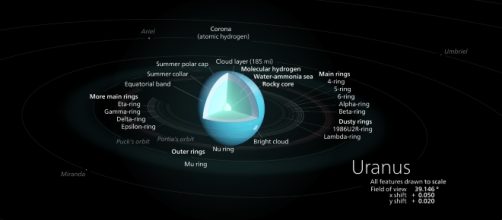Diamonds are as desirable as they are rare in the marketplaces of planet Earth, and that makes them very expensive. Both the demand and the scarcity are, however, largely artificial. Da Beers, a huge South African producer of diamonds, marketed diamonds in the 20th century, but the same company made the valuable stones rare by controlling their production to about 90 percent. In effect, it regulated the number of stones delivered to today’s jewelry stores.
It’s safe to say that the entire population wouldn’t mind owning a diamond or two, and while most of us aren’t given that opportunity, in Uranus, there’s hardly a scarcity of diamonds at all – in fact, it’s raining diamonds in Uranus and Neptune.
It rains solid diamonds on Uranus and Neptune
A group of scientists made this remarkable discovery when they imitated the conditions of Uranus and Neptune in their laboratory. While both have solid cores and atmospheres rich in gases including hydrogen and helium, the planets are largely made up of a huge, slushy ocean of water, ammonia, and substances known as hydrocarbons – molecules, such as methane, that are composed of hydrogen and carbon.
To recreate the diamond rain, head researcher Dominik Kraus, a physicist at the Helmholtz Dresden-Rossendorf Research Center in Germany, and his colleagues used an intense optical laser and an X-ray free electron laser to emit shockwaves through a block of polystyrene, which is a type of plastic composed of carbon and hydrogen.
As the team wrote this week in the journal Nature Astronomy, the optical laser the team employed created two shockwaves, which accurately simulated the temperature and pressure conditions at the intermediate layers of Uranus and Neptune – conditions similar to those found about 10,000 km into the interior of the planets. The first shock was smaller and slower, and was then overtaken by the stronger second shock. When they overlapped, the pressure peaked and tiny diamonds began to form.
Nearly every carbon atom in the polystyrene was incorporated into microscopic diamond structures up to a few nanometres wide. However, according to scientists, the diamonds formed in the planets’ core would be much larger, maybe millions of karats in weight.
Although the diamond formation lasted only fractions of a second, it was the first clear experimental proof of the theory.
Environment mimicking to further planetary studies
Because scientists are now able to reproduce an environment similar to the one located about 10,000 km in the interior of Uranus and Neptune, further research could show us if there are more stable options beyond diamond precipitation.
The success of the laser experiment may also provide a more eco-friendly way to make artificial diamonds. Currently, the sparkly gems are mainly produced with explosives to generate the high amount of pressure needed. The laser method developed by this study could provide a cleaner way to make diamonds.


